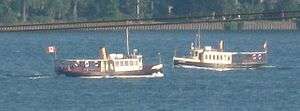MV Hiawatha
 Historic ferry Hiawatha passes her slightly younger berth-mate Kwasind. | |
| History | |
|---|---|
| Name: | Hiawatha |
| Owner: | Royal Canadian Yacht Club[1] |
| Port of registry: |
|
| Builder: | Bertram Engine Works |
| Completed: | 1895[1] |
| Status: | in active service |
| General characteristics | |
| Type: | Ferry |
| Tonnage: | 46 GT[2] |
| Length: | 56 feet (17 m)[2] |
| Beam: | 13.3 feet (4.1 m)[2] |
| Depth: | 6.3 feet (1.9 m)[2] |
| Propulsion: |
|
| Capacity: | 100 passengers[2] |
The Hiawatha is a passenger ferry built in 1895 for the Royal Canadian Yacht Club, in Toronto, Ontario, Canada.[1][3] She is 56 feet (17 m) long, 13.3 feet (4.1 m) wide, has a depth of 6.3 feet (1.9 m), and measures 46 gross tons. Her capacity is 100 passengers.[2] She was built by the Bertram Engine Works near Queen's Wharf and named for First Nation leader and co-founder of the Iroquois confederacy Hiawatha.
The Hiawatha is claimed to be the oldest passenger vessel still in active service on the North American Great Lakes.
The Hiawatha has served as a ferry for the yacht club since 1895. She was converted from a steam engine to a gasoline engine in 1944.[1]
On July 26, 2000, both the Hiawatha, and the yacht club's slightly newer ferry, the Kwasind, were sunk by vandals.[2][4] The Kwasind was refloated, and was back in working order the day of the sinking, while the Hiawatha required further repair.[5]
References
- 1 2 3 4 5 6 "Ship of the Month, No. 9 Hiawatha". Toronto Marine Historical Society. Archived from the original on 2013-11-22. Retrieved 2011-12-21.
Bearing this in mind, we find it surprising that very few of our Toronto members realize that they have, right under their noses, what appears to be the oldest operating passenger vessel on the Great Lakes.
- 1 2 3 4 5 6 7 Louis Surette (2000-07-27). "What lies beneath is ferry low blow". Toronto Star. p. B 07. Retrieved 2011-12-21.
The Hiawatha, built in 1895 and considered one of the world's oldest vessels still in daily service, was boarded and sunk by vandals at the yacht club's dock on Queens Quay, police said. The boat took club members and guests between the city and Toronto Island.
- ↑ "Doing water-tight deals". National Post. 2011-08-06. Archived from the original on 2013-11-22. Retrieved 2011-12-21.
The Royal Canadian Yacht Club, founded 1852, moved its clubhouse to Toronto Island in 1881; members and guests access the island with a pair of century-old ferry boats, the Hiawatha and Kwasind (names in a Longfellow poem).
- ↑ "Ferry Sinks". boatnerd. 2000-07-29. Archived from the original on 2012-07-29. Retrieved 2011-12-21.
The Hiawatha's sister vessel the Kwasind was also left semi-submerged and adrift, but was salvaged and returned to its dock. Police investigation continues but the police suspect that vandals opened the sea valves, allowing the vessel to fill with water.
- ↑ Greg Younger-Lewis (2000-08-22). "Cash reward offered to solve boat sinkings". Toronto Star. p. B 05. Retrieved 2011-12-21.